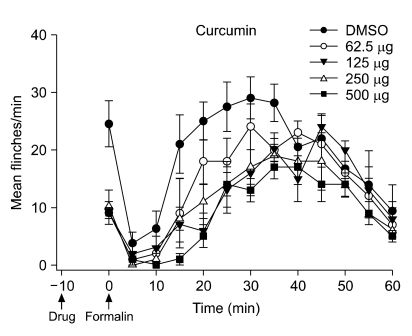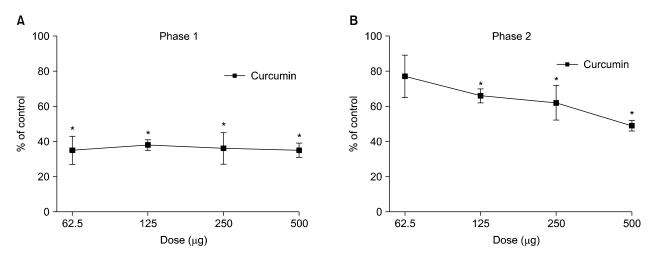Analgesic Effects of Intrathecal Curcumin in the Rat Formalin Test
- Affiliations
-
- 1Department of Anesthesiology and Pain Medicine, Chonnam National University Hospital, Gwangju, Korea. kimwm@chonnam.ac.kr
- KMID: 2278108
- DOI: http://doi.org/10.3344/kjp.2012.25.1.1
Abstract
- BACKGROUND
Curcumin has been reported to have anti-inflammatory, antioxidant, antiviral, antifungal, antitumor, and antinociceptive activity when administered systemically. We investigated the analgesic efficacy of intrathecal curcumin in a rat model of inflammatory pain.
METHODS
Male Sprague Dawley rats were prepared for intrathecal catheterization. Pain was evoked by injection of formalin solution (5%, 50 microl) into the hind paw. Curcumin doses of 62.5, 125, 250, and 500 microg were delivered through an intrathecal catheter to examine the flinching responses. The ED50 values (half-maximal effective dose) with 95% confidence intervals of curcumin for both phases of the formalin test were calculated from the dose-response lines fitted by least-squares linear regression on a log scale.
RESULTS
In rats with intrathecal administration of curcumin, the flinching responses were significantly decreased in both phases. The slope of the regression line was significantly different from zero only in phase 2, and the ED50 value (95% confidence interval) of curcumin was 511.4 microg (23.5-1126.5). There was no apparent abnormal behavior following the administration of curcumin.
CONCLUSIONS
Intrathecal administration of curcumin decreased inflammatory pain in rats, and further investigation to elucidate the precise mechanism of spinal action of curcumin is warranted.
Keyword
MeSH Terms
Figure
Cited by 5 articles
-
The effect of intrathecal curcumin on mechanical allodynia in rats after L5 spinal nerve ligation
Ju Hwan Lee, Yeon Dong Kim, Hoe Chang Jung, Yong Kwan Cheong
Korean J Anesthesiol. 2014;67(Suppl):S122-S123. doi: 10.4097/kjae.2014.67.S.S122.Antinociceptive role of neurotensin receptor 1 in rats with chemotherapy-induced peripheral neuropathy
Mei Yin, Yeo-Ok Kim, Jeong-Il Choi, Seongtae Jeong, Si-Ho Yang, Hong-Beom Bae, Myung-Ha Yoon
Korean J Pain. 2020;33(4):318-325. doi: 10.3344/kjp.2020.33.4.318.Curcumin and Its Emerging Role in Pain Modulation and Pain Management
Shailendra Kapoor
Korean J Pain. 2012;25(3):202-203. doi: 10.3344/kjp.2012.25.3.202.Evidence for the Participation of ATP-sensitive Potassium Channels in the Antinociceptive Effect of Curcumin
Marco Antonio De Paz-Campos, Aracely Evangelina Chávez-Piña, Mario I Ortiz, Gilberto Castañeda-Hernández
Korean J Pain. 2012;25(4):221-227. doi: 10.3344/kjp.2012.25.4.221.The Attenuation of Pain Behavior and Serum COX-2 Concentration by Curcumin in a Rat Model of Neuropathic Pain
Taraneh Moini Zanjani, Haleh Ameli, Farzaneh Labibi, Katayoun Sedaghat, Masoumeh Sabetkasaei
Korean J Pain. 2014;27(3):246-252. doi: 10.3344/kjp.2014.27.3.246.
Reference
-
1. Chainani-Wu N. Safety and anti-inflammatory activity of curcumin: a component of tumeric (Curcuma longa). J Altern Complement Med. 2003; 9:161–168. PMID: 12676044.
Article2. Huang MT, Lysz T, Ferraro T, Abidi TF, Laskin JD, Conney AH. Inhibitory effects of curcumin on in vitro lipoxygenase and cyclooxygenase activities in mouse epidermis. Cancer Res. 1991; 51:813–819. PMID: 1899046.3. Oetari S, Sudibyo M, Commandeur JN, Samhoedi R, Vermeulen NP. Effects of curcumin on cytochrome P450 and glutathione S-transferase activities in rat liver. Biochem Pharmacol. 1996; 51:39–45. PMID: 8534266.
Article4. Rao CV, Rivenson A, Simi B, Reddy BS. Chemoprevention of colon carcinogenesis by dietary curcumin, a naturally occurring plant phenolic compound. Cancer Res. 1995; 55:259–266. PMID: 7812955.5. Sharma S, Kulkarni SK, Agrewala JN, Chopra K. Curcumin attenuates thermal hyperalgesia in a diabetic mouse model of neuropathic pain. Eur J Pharmacol. 2006; 536:256–261. PMID: 16584726.
Article6. Yeon KY, Kim SA, Kim YH, Lee MK, Ahn DK, Kim HJ, et al. Curcumin produces an antihyperalgesic effect via antagonism of TRPV1. J Dent Res. 2010; 89:170–174. PMID: 20040737.
Article7. Zhao X, Xu Y, Zhao Q, Chen CR, Liu AM, Huang ZL. Curcumin exerts antinociceptive effects in a mouse model of neuropathic pain: Descending monoamine system and opioid receptors are differentially involved. Neuropharmacology. 2011; [in press].
Article8. Banerjee M, Tripathi LM, Srivastava VM, Puri A, Shukla R. Modulation of inflammatory mediators by ibuprofen and curcumin treatment during chronic inflammation in rat. Immunopharmacol Immunotoxicol. 2003; 25:213–224. PMID: 12784914.
Article9. Xu YX, Pindolia KR, Janakiraman N, Chapman RA, Gautam SC. Curcumin inhibits IL1 alpha and TNF-alpha induction of AP-1 and NF-kB DNA-binding activity in bone marrow stromal cells. Hematopathol Mol Hematol. 1997-1998; 11:49–62. PMID: 9439980.10. Goel A, Boland CR, Chauhan DP. Specific inhibition of cyclooxygenase-2 (COX-2) expression by dietary curcumin in HT-29 human colon cancer cells. Cancer Lett. 2001; 172:111–118. PMID: 11566484.
Article11. Yamamoto T, Nozaki-Taguchi N. The role of cyclooxygenase-1 and -2 in the rat formalin test. Anesth Analg. 2002; 94:962–967. PMID: 11916805.
Article12. Coderre TJ, Abbott FV, Sawynok J. Schmidt RF, Willis WD, editors. The formalin test. Encyclopedia of pain. 2007. New York: Springer;p. 795–799.13. Sommer C, Sorkin LS. Schmidt RF, Willis WD, editors. Cytokines as targets in the treatment of neuropathic pain. Encyclopedia of pain. 2007. New York: Springer;p. 518–520.
Article14. Yaksh TL, Rudy TA. Chronic catheterization of the spinal subarachnoid space. Physiol Behav. 1976; 17:1031–1036. PMID: 14677603.
Article15. Tallarida RJ. Drug synergism and dose-effect data analysis. 2000. Boca Raton (FL): Chapman and Hall/CRC.16. Puig S, Sorkin LS. Formalin-evoked activity in identified primary afferent fibers: systemic lidocaine suppresses phase-2 activity. Pain. 1996; 64:345–355. PMID: 8740613.
Article17. Mittal N, Joshi R, Hota D, Chakrabarti A. Evaluation of antihyperalgesic effect of curcumin on formalin-induced orofacial pain in rat. Phytother Res. 2009; 23:507–512. PMID: 19051211.
Article18. Tsai YM, Chien CF, Lin LC, Tsai TH. Curcumin and its nano-formulation: the kinetics of tissue distribution and blood-brain barrier penetration. Int J Pharm. 2011; 416:331–338. PMID: 21729743.
Article19. Fairbanks CA. Spinal delivery of analgesics in experimental models of pain and analgesia. Adv Drug Deliv Rev. 2003; 55:1007–1041. PMID: 12935942.
Article20. Fitzgibbon DR. Fishman SM, Ballantyne JC, Rathmell JP, editors. Cancer pain: principles of management and pharmacotherapy. Bonica's management of pain. 2009. 4th ed. Philadelphia: Lippincott Williams & Wilkins;p. 583–603.21. Satoskar RR, Shah SJ, Shenoy SG. Evaluation of anti-inflammatory property of curcumin (diferuloyl methane) in patients with postoperative inflammation. Int J Clin Pharmacol Ther Toxicol. 1986; 24:651–654. PMID: 3546166.22. Deshpande SS, Lalitha VS, Ingle AD, Raste AS, Gadre SG, Maru GB. Subchronic oral toxicity of turmeric and ethanolic turmeric extract in female mice and rats. Toxicol Lett. 1998; 95:183–193. PMID: 9704820.
Article23. Kandarkar SV, Sawant SS, Ingle AD, Deshpande SS, Maru GB. Subchronic oral hepatotoxicity of turmeric in mice--histopathological and ultrastructural studies. Indian J Exp Biol. 1998; 36:675–679. PMID: 9782784.
- Full Text Links
- Actions
-
Cited
- CITED
-
- Close
- Share
- Similar articles
-
- The Analgesic Effects of Intrathecal Pregabalin in Rat Formalin Tests: Comparison between Pre- and Post-treatment
- Antinociceptive effects of intrathecal cimifugin treatment: a preliminary rat study based on formalin test
- Differential expression of spinal γ-aminobutyric acid and opioid receptors modulates the analgesic effects of intrathecal curcumin on postoperative/inflammatory pain in rats
- Comparison of Antinociceptive Effect of Pre- versus Post-treatment with Intrathecal Ketamine on the Formalin Test in Rats
- Antinociceptive Effects of Intraperitoneal and Intrathecal Vitamin E in the Rat Formalin Test



